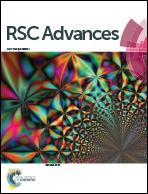In situ synthesis of flame retardant organic–inorganic hybrids by a molten blending method based on thermoplastic polyurethane elastomer and polybutyl titanate
Abstract
A novel type of organic–inorganic hybrid prepared using an in situ synthesis method by molten blending polybutyl titanate (BTP) and thermoplastic polyurethane elastomer (TPU) is reported. Structure characterization indicated that titanium compounds dispersed homogeneously in a polyurethane resin with an amorphous structure. The flame retardant and smoke suppression properties of the organic–inorganic hybrids were intensively investigated using the limiting oxygen index (LOI), cone calorimeter test (CCT), microscale combustion colorimeter test (MCC), and thermogravimetric/infrared spectroscopy (TG-IR). The CCT results showed that the peak heat release rate (pHRR) value of the sample with 0.5 wt% BTP decreased by 69.9%; the peak smoke production rate (pSPR) value decreased by 63.9%; the mass of residual carbon residue increased by 88% compared with pure TPU. The TG-IR data showed that titanium compounds from the hydrolysis of BTP promoted the release of H2O and CO2 at the beginning of the decomposition, whereas they reduced the production of H2O and CO2 at high temperatures. This study gives a new method to fabricate flame retardant polymers by the in situ synthesis of organic–inorganic hybrids, which has very good development prospects.


 Please wait while we load your content...
Please wait while we load your content...